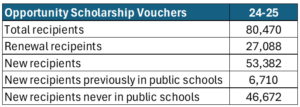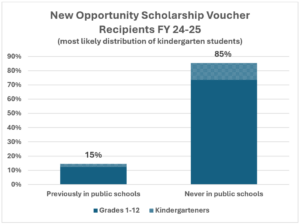New data confirms NC school voucher expansion disproportionately benefits wealthy private school families
A new report from the Department of Public Instruction (DPI) confirms what school voucher opponents have been saying: universal voucher programs are a wasteful giveaway to disproportionately wealthy families who have already enrolled their children in private schools.
According to the report, just 6,710 of the state’s 80,470 Opportunity Scholarship vouchers in the 24-25 school year went to students who had attended a North Carolina public school in the prior school year. The report did not examine the prior school enrollment of the 27,088 recipients who renewed the previous year’s voucher for 24-25, examining solely the prior school enrollment of this year’s 53,382 first-time voucher recipients.
The startling takeaway is this: a whopping 87 percent of new school vouchers in 24-25 went to families who have never attended a public school.

Diving deeper into the data, approximately 7,301 of the Opportunity Scholarship voucher recipients are kindergarteners. If we assume these kindergartners would have attended public schools in the same proportion as students currently in grades 1-12, it follows that 14.6 percent of the kindergarten recipients (1,063 students) would have likely attended a public school in the absence of the voucher program. This assumption means that most likely, 85 percent of school voucher money is being funneled to students who were always planning to attend private schools.

The data confirms voucher opponents’ predictions of who would benefit from 2023 legislation eliminating income caps and prior public school enrollment requirements. By making the program “universal,” the General Assembly always intended the voucher program to benefit disproportionately wealthy families who had already enrolled their children in private schools. For context, the median household with a child in private school earns nearly double the typical household in North Carolina.
This new data places North Carolina’s program near the top of state voucher programs when it comes to paying private school families to do something they were already doing.
| Voucher State | Percent Never in Public School | Source |
| Arizona | 75% | link |
| Arkansas | 95% | link |
| Florida | 69% | link |
| Indiana | > 67% | link |
| Iowa | 66% | link |
| Missouri | 60% | link |
| New Hampshire | 89% | link |
| North Carolina | 87% | |
| Ohio | 64% | link |
| Wisconsin | 75% | link |
DPI’s report also calculates the amount of funding the state “saved” because these students departed the public school system. According to the report, the state would have spent an additional $10.1 million had these students remained in public schools. A provision in the 2023 Budget suggests that the General Assembly may create a new proposal to send this amount back to the public schools to help offset the budget pressures created by this voucher scheme.
It is unlikely that any such support – if it were ever to materialize – would materially benefit the public schools suffering from the double-whammy of austerity budgets and unfettered school choice. Much like the Lottery money, any funds earmarked to offset voucher students would simply supplant other state revenue for schools, leaving total state spending unchanged.
Outside of the DPI report, other new program data shows that North Carolina’s wealthiest families are benefiting to an even greater extent than originally predicted. According to the North Carolina Education Assistance Authority, 20 percent of this year’s new voucher recipients are from families in the highest income bracket ($259,750 or more for a family of four). The Justice Center’s EdLaw Project had originally predicted that 16 percent of new vouchers would go to students in the highest income bracket.
Voucher proponents have never fully explained why it makes sense to spend money subsidizing wealthy families who have already enrolled their children in private schools. EdLaw reached out to Rep. Tricia Cotham, who led the House’s efforts to open the Opportunity Scholarship voucher to wealthy private school parents, but did not receive a response as of publication date.
As a reminder, voucher programs don’t just subsidize wealthy families in unregulated (and often low-quality) private schools. They also actively harm students in our traditional, inclusive public schools. The harms to public school students include:
- Exacerbating racial and economic segregation
- Reducing state revenue availability for public schools
- Driving up per-student public education costs by “cropping and creaming” advantaged students from public schools
- Contributing to declining public school enrollment and harmful school closures
- Undermining public support for the collective benefits of public schools
The preponderance of evidence indicates that vouchers are part of lawmakers’ larger efforts to undermine public schools. Public schools that foster cross-racial and cross-class solidarity strengthen multiracial democracies but threaten the hierarchies benefiting the current political leadership in both Raleigh and Washington.
This new data should serve as a wake-up call to legislators: There is no public benefit to subsidizing the private school tuition of disproportionately wealthy families who already planned to send their kids to private schools. Instead, lawmakers should shift this funding to public schools – particularly if targeted to schools with the highest needs. As the research shows, deploying these resources in our public schools would make our education spending more equitable and efficient, better preparing students for participation in the democratic process and a modern economy.
 Justice Circle
Justice Circle